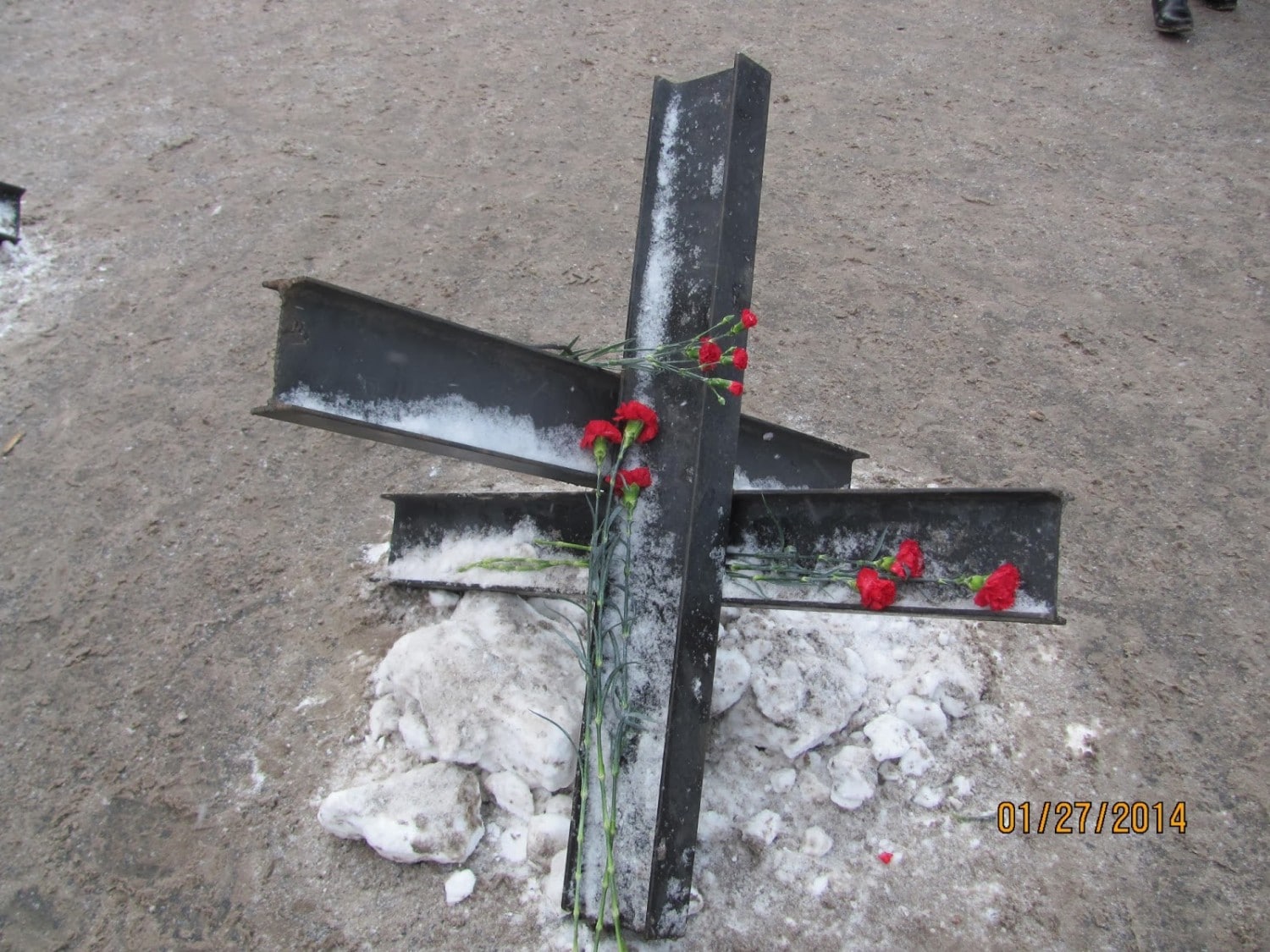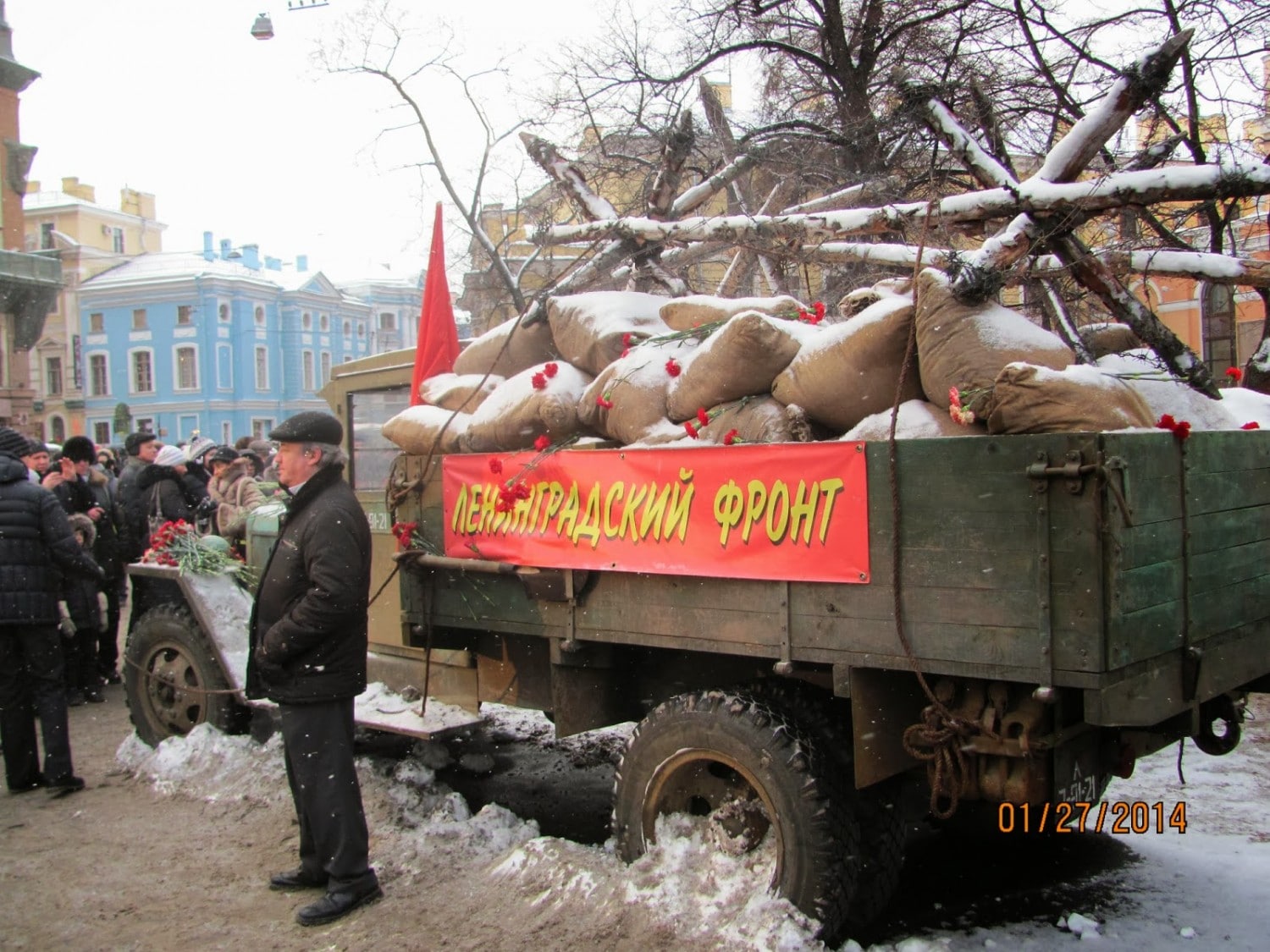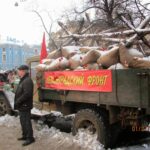Jan 27, 2014 was the 70th anniversary of the end of the Siege of Leningrad. During the Great Patriotic War (WWII) German forces cut off the Soviet city of Leningrad (now Saint Petersburg) from the rest of the country with intense bombing raids and tank roadblocks. The siege lasted for 872 days: from September 8 1941, until 27 January 1944. Estimates vary, but over a million civilians and soldiers died during the blockade- many of starvation.
In case you don’t know this incredible history, watch this YouTube video:
There were several events and exhibits set up for the anniversary across the city. At the corner of Ulitsa Italianskaya and Ulitsa Malaya Sadovaya was a large outdoor display serving as a temporary museum for the Siege of Leningrad. There were lots of period vehicles from the blockade- trolleybuses, military trucks, even a fire truck! They also had a video screen playing a short film about the blockade, announcements from a loud speaker taken from actual public broadcasts that played during the blockade, posters and flyers set up like 1942 to create the atmosphere of the time, and a wall of one building was converted into a poster board with texts and pictures explaining Leningrad’s role in WWII.

I had read that at 7:00 there would be a candlelight procession down Nevsky Prospekt from the outdoor display at Ulitsa Malaya Sadovaya to Palace Square, so later that night I put on my warmest clothes and ventured outside again. At this point it was snowing lightly, really beautiful as the sun had mostly set and the streetlamps and shop windows were the only illumination- until I got to Nevsky. Of course, there were plenty of cars, but also hundreds of candles! I smelled them first, the pleasant burning scent, and then slowly noticed all the dots of flame twinkling across the crowd gathered on the sidewalk. I expected that stretch of Nevsky Prospekt to be closed down for the procession- the idea was to have 1,944 volunteers (the year the siege ended) march to Palace Square, and there form a human sign spelling out “900 Days” (to represent the approximate length of the blockade).
I waited in a crowd of people where I read the procession would start. A blockade-era trolleybus idled on the street, its loudspeaker played Soviet war songs and announcements. Exactly at 7:00PM the speakers blared “NOW, A MINUTE OF SILENCE”. Nevsky Prospekt froze. Not just the people clearly involved, holding candles, but mothers pushing babies in strollers, people walking home from the grocery store, young children- as far as I could see there was barely any movement or speech. The trolleybus ticked off the sound of the famous Leningrad metronome (during the Blockade music was broadcast over the Leningrad radio 24/7. At rare times when music was not broadcast, a metronome was placed before the radio microphone to assure the people that the resistance was ongoing) for one minute, as we all let the weight of the anniversary really sink in. Abruptly, the trolleybus began to play music again and people scattered in all directions. Did I miss the parade? I stood in my spot for a moment, craning my neck up and down the street searching for any banners or flags. I wasn’t even positive which direction Palace Square was in…but the people with the candles were surging to the right, so I tentatively followed them.

About five minutes later, I realized that I was, in fact, IN the procession. I’m still not sure if there was a more formal procession, but there were news cameras set up all along the route, interviewing people, and people hanging out of windows above us taking pictures. I embraced my new found membership and committed to march the 30 minutes to Palace Square. Even though I didn’t have a candle, it was impossible not to feel a heaviness and solemnity being part of such an important remembrance. Every person over the age of 70 is a possible survivor, most of these people’s parents or grandparents were in the blockade…and I am a lone American girl, a tourist, trying to adopt a city I have no right to call my own. Perhaps after today I’ve gotten a little closer to earning that right.
The events at Palace Sqaure were wonderful. All the streetlights and windows were dark in the square, giving the effect of the blockaded city at night, cloaking itself from Nazi bombers. There was a semi-circle of antique military vehicles on the far side and several stages set up in the center. I watched a teen pop quintet sing about the beauty of “our Saint Petersburg, dear Leningrad” and a man sing “we’re with you, the people of Leningrad/ we know what war means” (excellent song and lyrics). Then a loud siren sounded and the entire 100-foot side of a neoclassical 18th century building lit up with a projected short documentary about the blockade with video footage and pictures from the war. After the film, another parade entered. All the vehicles from the outdoor display near my apartment rolled into Palace Square! People were cheering and throwing roses into the truck beds; it was all very moving. The night was capped off with a fireworks display. I didn’t count, but I was told they set off 70 rockets for the 70th anniversary.
I learned so much about the Siege of Leningrad today and how even 70 years later it is still a deep part of the consciousness and identity of the people of the hero-city of Leningrad. I hope this blog post recognized the event as it deserves and piques your interest to learn more about the Eastern front of World War II!










